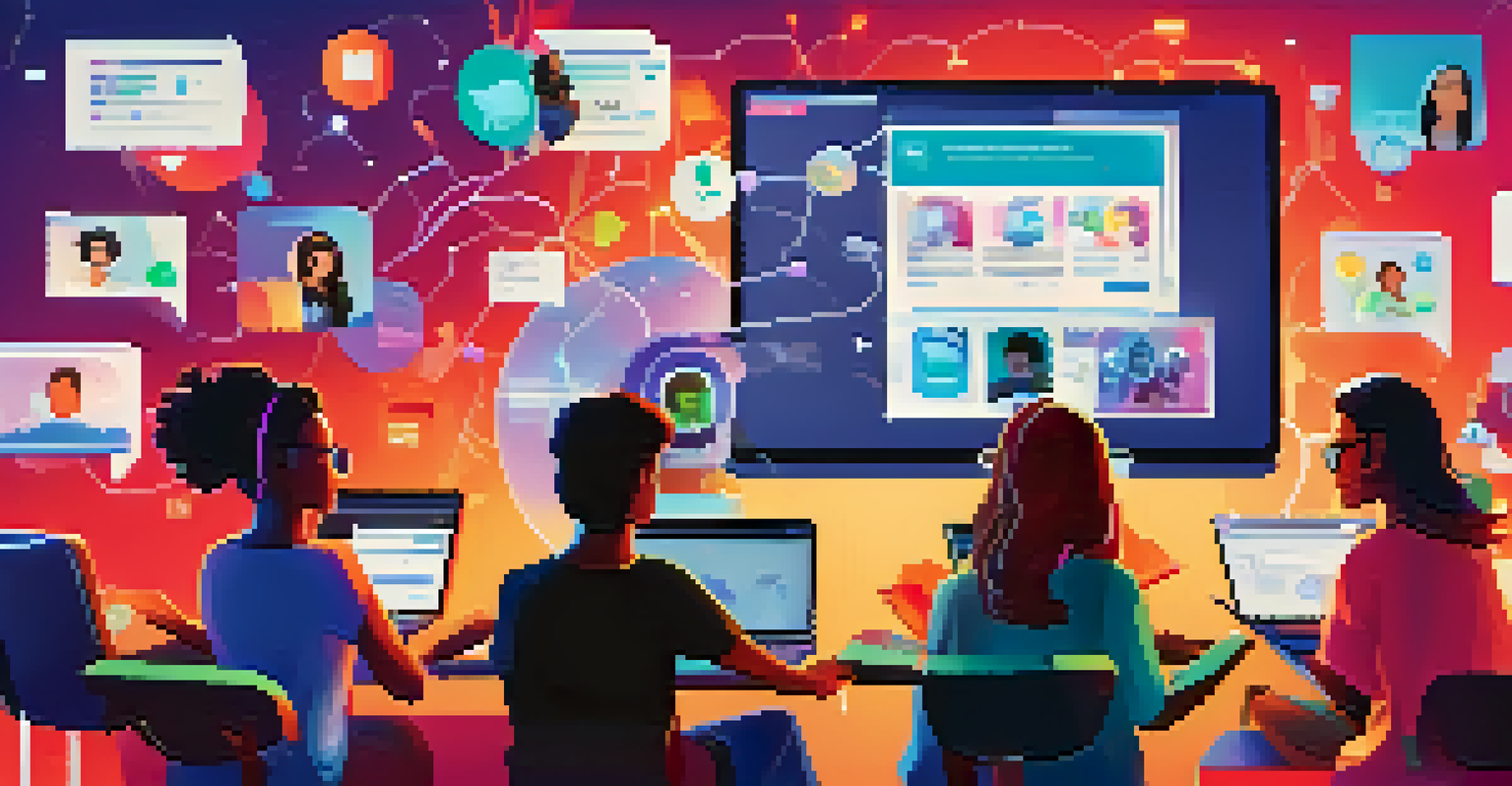Social Interaction and Learning: A Neuroscientific View

The Importance of Social Interaction in Learning
Social interaction plays a crucial role in how we learn. When we engage with others, we're not just sharing information; we're also experiencing emotional connections that enhance our understanding of the material. This collaborative environment fosters deeper cognitive engagement, making learning more effective and enjoyable.
Tell me and I forget, teach me and I remember, involve me and I learn.
Consider a classroom setting where students discuss concepts together. This exchange of ideas stimulates critical thinking and allows them to approach problems from multiple angles. The shared experience also creates a sense of belonging, which can further motivate individuals to learn and participate.
Neuroscientifically, social interaction activates specific brain regions associated with learning and memory. These interactions can lead to the release of neurotransmitters like dopamine, which not only boosts our mood but also enhances our ability to retain information. This illustrates just how intertwined social experiences and learning really are.
Neuroscience Behind Social Learning Mechanisms
At the core of social learning are mirror neurons, which are brain cells that fire both when we perform an action and when we observe someone else doing it. This fascinating mechanism allows us to learn through imitation, making social environments rich with learning opportunities. For example, watching a peer solve a math problem can give a student the insight they need to tackle a similar challenge.

Moreover, social learning is not just about mimicking actions; it also involves understanding intentions and emotions. Our brains are wired to empathize with others, and this empathy drives us to learn from their experiences. When we relate to the struggles or successes of others, we internalize these lessons more effectively.
Social Interaction Enhances Learning
Engaging with others fosters emotional connections that deepen understanding and make learning more enjoyable.
Additionally, social contexts often present challenges that require collaboration, further enhancing learning. When navigating group dynamics, individuals develop critical problem-solving skills and adaptability. This not only enriches their knowledge base but also prepares them for real-world scenarios where teamwork is essential.
Impact of Emotional Connections on Learning
Emotions play a pivotal role in learning, especially in social contexts. Positive emotional connections with peers can create a safe space for exploration and risk-taking, which are vital for effective learning. When students feel supported, they're more likely to engage deeply with the material and express their thoughts freely.
The greatest gifts you can give your children are the roots of responsibility and the wings of independence.
Conversely, negative emotional experiences can hinder the learning process. Stress and anxiety can trigger the brain's fight-or-flight response, making it difficult to focus and retain information. This is why fostering positive relationships in educational settings is essential for creating an optimal learning environment.
Research shows that when we experience joy or excitement during learning, our brains are more receptive to absorbing new information. This underscores the importance of social interactions that promote positive emotions, highlighting that learning is not just a cognitive endeavor but also an emotional journey.
The Role of Collaborative Learning Environments
Collaborative learning environments leverage the power of social interaction to enhance educational outcomes. In these settings, students work together to explore concepts, share knowledge, and solve problems collectively. This approach not only fosters a sense of community but also cultivates essential skills like communication and teamwork.
The dynamics of collaborative learning often lead to richer discussions and a variety of perspectives. When students articulate their thoughts and listen to others, they engage in critical thinking and reflection. This interaction helps solidify their understanding and encourages them to consider different viewpoints.
Emotions Impact Learning Outcomes
Positive emotional connections create a safe learning environment, while negative emotions can hinder focus and retention.
From a neuroscientific perspective, collaborative learning can activate networks in the brain that are responsible for social cognition and communication. As students interact and negotiate meaning, they are effectively rewiring their brains to enhance learning. This demonstrates that learning is a dynamic process, influenced significantly by our social experiences.
Technology’s Influence on Social Learning
In today's digital age, technology has transformed how we engage socially while learning. Online platforms and social media facilitate connections among learners from diverse backgrounds, creating opportunities for collaborative learning beyond geographical boundaries. This digital interaction can enrich the educational experience significantly.
For instance, virtual study groups and discussion forums allow students to share resources, ask questions, and provide support to one another in real-time. This sense of community can enhance motivation and accountability, leading to improved learning outcomes. In many cases, these online interactions foster relationships that extend beyond academic needs.
However, it's important to balance online interactions with face-to-face connections. While technology can enhance social learning, genuine human interaction remains vital for emotional and cognitive development. Finding that balance can lead to a more integrated learning experience that fully harnesses the benefits of both worlds.
Barriers to Effective Social Learning
Despite the many benefits of social learning, there are barriers that can impede its effectiveness. One significant barrier is the fear of judgment, which can prevent individuals from expressing their thoughts and participating in discussions. When learners feel anxious about how they will be perceived, they may hold back, hindering the collaborative process.
Another barrier is the lack of diversity in social interactions. If learners are only exposed to similar perspectives, they may miss out on valuable insights that come from engaging with diverse groups. This can lead to a narrow understanding of concepts and limit critical thinking.
Technology Supports Collaborative Learning
Digital platforms facilitate connections and collaborative opportunities among learners, enhancing motivation and accountability.
To overcome these barriers, educators and facilitators should create inclusive environments that promote openness and respect. Encouraging risk-taking and celebrating diverse viewpoints can foster a richer learning experience. By addressing these challenges, we can unlock the full potential of social interaction in learning.
Future Directions in Social Learning Research
As we continue to explore the intersection of social interaction and learning, future research will delve deeper into the neuroscience behind these processes. Understanding how different social contexts affect learning outcomes could lead to more effective teaching strategies and educational frameworks. For instance, investigating the impact of group dynamics on learning could reveal new ways to optimize collaborative environments.
Additionally, the evolving landscape of technology presents new avenues for research. As virtual and augmented reality become more integrated into learning experiences, examining their effects on social interaction and cognitive development will be essential. This could transform how we approach education in a digital world.

Ultimately, the goal of this research will be to create learning environments that harness the power of social interaction, ensuring that all learners can thrive. By continuously studying and adapting our approaches, we can foster a culture of collaboration that enriches the educational experience for everyone.